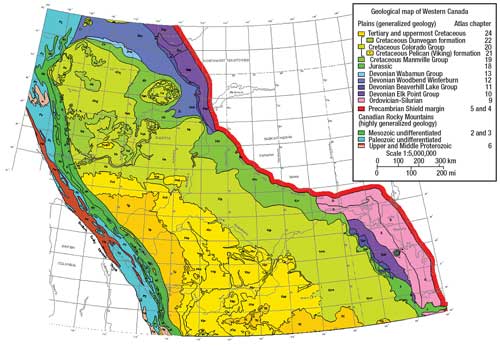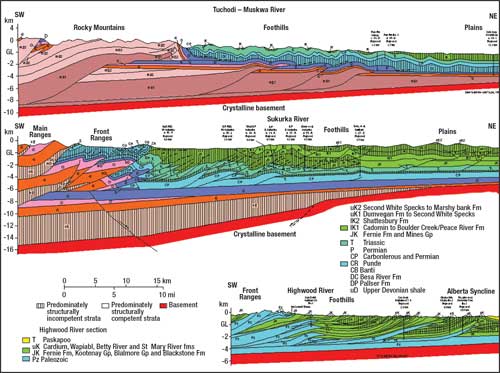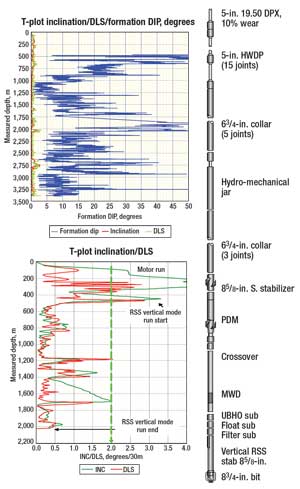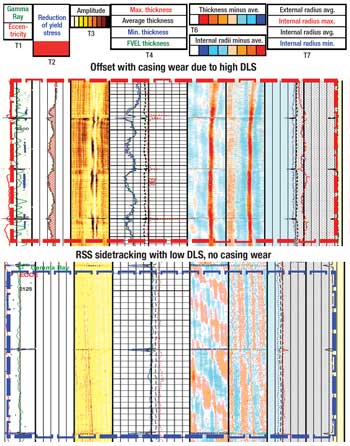DRILLING TECHNOLOGY
Rotary steerable system technology case studies in the Canadian Foothills: A challenging drilling environment
Crossing high-angle faults, highly dipping formations in hard rock tests the mettle of RSS systems.
Essam Adly, Schlumberger and Bob Staysko, Suncor Energy Inc.
The Canadian foothills are situated in a challenging drilling environment with deep wells in hard, abrasive formations that lead to extended drilling time. Casing wear can occur in the upper sections, and special care must be taken to ensure casing integrity throughout the life of the well. Studies have shown that even slight doglegs in this vertical section lead to localized “hot spots,” where erosion of the casing is focused. Keeping the well straight in this highly dipping formation has been a priority for drilling companies and operators.
Rotary Steerable Systems (RSS) have assisted in drilling wells in the Canadian Foothills. Using a “closed loop” feature, which automatically seeks a vertical profile in an openhole sidetrack with a carefully controlled dogleg severity (DLS), the rotary steerable tool is proving useful in drilling wells and reducing risks.
This paper describes the use of RSS in drilling applications. Case studies illustrate RSS benefits.
INTRODUCTION
A quick look at Western Canada drilling environments leads us to operation segmentation from medium- to high-cost operation. This paper concentrates on drilling in the Foothills, which is considered high cost related to many factors: surface locations in mountainous terrain; high formation dip, especially in surface holes; highly faulted areas that lead to geological uncertainty; and harsh drilling environments related to abrasive formation, shock and vibration, with slow penetration rates.
After the introduction of RSS technology in many parts of the world, it proved to be an excellent match for medium-to-high drilling cost environments. Recently, RSS tools have been introduced to high-cost drilling operations in Western Canada, specifically targeting the Foothills, where the RSS tool aids the operator in reducing drilling costs.
Drilling in the Foothills is subject to drilling shock and vibration, which can cause premature failure in downhole equipment and lead to Bottomhole Assembly (BHA) failures. In addition, the abrasive formation limits the number of hours for every bit run before tripping just to change the bit. Drilling with RSS adds more power to the drillstring.
GEOLOGICAL BACKGROUND
The Rocky Mountain Foothills in Alberta are located between the Western Canadian Sedimentary Basin (WCSB) and the Rocky Mountains. This fold and thrust belt was formed by shortening the Paleozoic and Mesozoic rocks in the late Jurassic to Eocene as terrain accretion occurred on the western margin of North America. Within the Foothills, thrust faulting has contributed to structural shortening.
The Rocky Mountain Foothills are the focus of ongoing hydrocarbon exploration in Western Canada. To date, most geophysical exploration has used seismic technology to yield clear images of 3D structures. However, the complicated geology and rugged terrain present drilling challenges, Fig. 1 and Fig. 2.
 |
Fig. 1. Geological map of the Western Canada Sedimentary Basin.
|
|
 |
Fig. 2. Structural styles of the fold and thrust belt, eastern section.
|
|
The western margin of the WCSB has a long tectonic history dominated by extension during the Proterozoic to the Triassic, and compressive deformation during the Middle Jurassic to the Eocene.1 The compressive tectonic movements caused significant shortening of the western margin of the WCSB and created both the Rocky Mountains and the Foothills.1
The tectonic setting has controlled the stratigraphy of the Rocky Mountain Foothills. The Paleozoic succession is composed of marine carbonate sediments. Clastics, such as shale, siltstones, and sandstones, dominate the Mesozoic succession.1 Overthrust faults and folds developed in the Rocky Mountain Foothills as a consequence of intense compressive deformation. Structures in the Foothills are complex, and different structural styles have developed in response to varying lithology. A northward trend in structural style from thrust-dominated in the south to fold-dominated in the north can be observed,1 which is consistent with the trend of a northward decrease in competency of the Phanerozoic sedimentary sequence.
The geological formations exposed in the Foothills range in age from the Mississippian to the Paleocene, and subsurface rocks are known to be of Cambrian to Devonian age from wells drilled in the area. These formations have been described in detail in many publications, and stratigraphic succession is well established. Generally, formations in the western Foothills are thicker than formations in the east. The maximum aggregate thickness represented above the Proterozoic basement is about 9,000 m.2
TRADITIONAL DRILLING APPROACH
Steerable Positive Displacement Motors (PDM) have been used for the majority of directional drilling work in the Foothills. Steerable motor drilling is a relatively inefficient process, with associated problems of trajectory control in unstable formations, high-dip formations, slow penetration rates, pipe sticking and slide drilling.
Steerable motor drilling requires sliding of the BHA in order to steer the wellpath; therefore, drilling becomes slower and potentially more problematic. Rate of penetration (ROP) is negatively impacted as a result of wellbore friction, and BHA encounters hang ups. The transition from slide to rotate requires rotating the motor bend through the section steered, and rotation is necessary because hole cleaning without drillstring rotation causes cuttings to drop out of suspension to the low side of the hole.
Steering a motor requires maintaining the orientation of the bend in the desired toolface setting. Reactive torque from the motor itself works against toolface control, with the force turning the string in a counterclockwise direction. The magnitude of reactive torque will depend on the torque being generated at the bit, which itself is a function of bit aggression, motor torque output, and the formation being drilled. As a result, a compromise on bit selection is frequently made for steerable motor drilling.
Microtortuosity associated with a slide-and-rotate sequence is particularly significant in many regional reservoirs. Coiled-tubing accessibility can be severely impacted by a tortuous wellpath in the reservoir. In a 6-in. hole, extended power motors are susceptible to formation effects and can be difficult to stabilize, resulting in a tortuous wellpath in the reservoir.
RSS TECHNOLOGY
Exploration and production (E&P) companies plan challenging wellbore trajectories that push the limits of directional-drilling technology, while simultaneously seeking cost savings and improved operational quality.
Rotary steerable drilling technology entered into the market in the late 1990s. The technology has advanced considerably, offering increased flexibility, greater reliability, and higher rates of penetration. These high-performance systems facilitate drilling complicated wellbore trajectories in harsh environments. With industry costs for nonproductive drilling time estimated at $5 billion per year, RSS may prevent or reduce losses.
Engineering service contractors have developed distinct rotary steerable systems for different applications. These systems share several features, including continuous rotation of external components at the same speed as the bit.
The RSS family can be divided into two principal technologies: “push-the-bit” and “point-the-bit”. In push-the-bit technology (side forces), the RSS tool relies on the application of force outwards against the wellbore to push the bit and deflect the BHA to the opposite or resultant direction. In point-the-bit technology (bit tilt); the RSS tool achieves wellbore deflection by bending a shaft or using a tilted device within the tool itself. Beneficially, the RSS tool does not have to rely on the wellbore condition, and the tool requires less reaction from the formation.
Ultimately, “shoe-to-shoe”-rotary steerable drilling could allow companies to drill out the casing shoe and continue drilling to the next casing point in a single run.
RSS technology has achieved the benefits of directional control with the subsequent mitigation of drilling associated problems. RSS provides prevention of cuttings accumulation around the BHA and the ability to back ream, which minimizes the possibility of getting stuck and eliminates the need for dedicated wiper trips. Application of RSS technology combines penetration rate enhancement and better hole quality to increase drilling efficiency and speed production.
CANADIAN OPERATORS’ DRIVERS AND NEEDS
Main incentives to use RSS technology include improving operational efficiency through the mitigation of drilling risks, and optimizing drilling performance by applying new technology that will add value to the operation and reduce drilling time compared to conventional drilling. Through close monitoring of historical wells drilled with conventional motor systems in the Foothills, most challenges were found in the directional profile, sliding-related hole problems and bit selection.
Challenges are:
- Casing wear
- Hole cleaning
- Stuck pipe
- Low ROP
- Number of BHAs
- Excessive torque and drag due to the microdoglegs created with frequent slides.
CASE STUDIES
The following cases discuss different applications of RSS technology in the Canadian Foothills.
Case 1-Operator with vertical drilling application. Operators drilling in the Foothills area face the following drilling challenges:
- Maintain vertical hole through high-dip formation.
- Endure slow drilling related to very hard, abrasive formations.
- Minimize the number of BHAs to drill surface-hole sections and avoid correction runs to bring the well back to vertical.
- Avoid casing wear, which is a drilling risk in sour gas environments.
- Minimize DLS. Doglegs present in the wellbore will create hot spots in areas where the casing bends. The severity of hot spots can be reduced with dedicated reaming runs prior to running casing, which will require additional time and money. In addition, dogleg locations must be recorded to allow for reference and monitoring when inspecting casing.
- Minimize Torque and Drag (T&D). High doglegs in the top section of wells created by correction slides in high-dip intervals cause excess torque and drag. The length of the horizontal (HZ) lateral is affected by the high T&D, and torque reducers (e.g., lubricants, beads and vibration tools) are required to achieve the geological objectives.
The objective was to maintain the well close to vertical and to drill as deep as possible (2,000-3,500 m) before reaching kickoff point (KOP). Minimizing doglegs was important to run casing to the bottom without creating hot spots, which could create casing wear and affect well integrity in the future. Most of these wells were planned as deep wells with final total depths at 4,000-6,900 m, with a stepout of 1,800-3,000 m.
The execution phase used the RSS in a 16-in., 12¼-in. and 8 1/2-in. (406-mm, 311-mm, 216-mm) hole.
Case 1-Evaluation of RSS performance. Significant time and cost savings were achieved compared to offset wells drilled with PDM; the drilling maintained inclination and DLS below 2°, which was agreed to be the threshold. Figure 3 shows the wireline dip logs from the well, and data allows users to quantify how the RSS performs against the formation dip. In some cases, the formation evaluation program did not run logs. In this case, data was compared with the offset wells drilled by PDM.
 |
Fig. 3. Case 1 - Vertical drilling application of RSS technology.
|
|
Case 2-Operator with directional drilling application. In Case 2, the operator used the RSS and a motor with an inclination-hold function to drill the 8¾-in. (222-mm) hole section, building to 35° inclination. The operator then drilled the long tangent section about 2,000 m as smoothly as possible, while keeping the trajectory through steeply dipping beds, and keeping surface rotations between 30 and 60 rpm to minimize the casing wear caused by rotation.
Using the RSS allowed the operator to finish the section 4 days ahead of schedule with excellent hole condition, saving 5 days and eliminating planned wiper trip in-ream and back-ream time. Figure 4 highlights the comparison to offset wells.
 |
Fig. 4. Case 2 - Comparison of RSS drilled wells to offset wells.
|
|
Case 3-Operator with sidetracking application. An active operator has six rigs drilling in the Alberta Foothills area with the following drilling challenges:
- High density fault area with wellbore instability issues related to drilling hazards such as shale and coal
- Slow drilling operations related to very abrasive formation
- Minimize doglegs and DLS to prevent the future occurrence of casing wear hot spots in areas where the casing bends, which is a drilling risk in sour gas drilling environments.
Operator objectives were to sidetrack the well after getting stuck in the 12¼-in (311-mm) hole and to minimize doglegs to run casing to bottom without creating hot spots, while maintaining the well integrity to the final well TD at about 6,800 m.
The RSS was used during the execution phase. The sidetrack took place in the 12¼-in. intermediate hole at 2,130 m. After dressing the openhole cement plug, the RSS drilled a 12¼-in. hole from 2,130 m with a smooth DLS (2°/30 m) to 2,246 m, while building angle from 0.2° to 6.93° in the right azimuth direction of 268°. Drilling the 9 5/8-in. (244.5-mm) casing progressed with no problems.
Case 3-Evaluation of the RSS performance. For this well, the following benefits were noted:
- Time and cost savings were achieved compared to the offsets wells drilled and sidetracked with PDM, Fig. 5.
- Excellent hole quality was maintained, allowing casing to be run.
- Casing wear log showed minimal wear after 30 days.
There was also minimal wear at the sidetrack depth. The 9 5/8-in. (244.5 mm) production casing had sufficient burst integrity to continue drilling with no drillpipe protectors.
 |
Fig. 5. Case 3-Sidetrack application of RSS compared to offset well drilled with PDM.
|
|
CONCLUSIONS
RSS technology is becoming the choice for drilling applications that begin with drilling to maintain the well verticality with minimal inclination and minimal DLS, which could affect well integrity. RSS eliminates any need for correction runs; in addition, RSS improves drilling efficiency in deviated and horizontal drilling by eliminating sliding intervals. RSS also accomplishes faster rates of penetration and smoother boreholes with better hole cleaning, which eliminates the need for dedicated wiper trips and yields subsequent cost benefits in the overall drilling operation as well as early well production. 
LITERATURE CITED
1 Wright G. N., McMechan M. E., and D. E. G. Potter, Geological Atlas of the Western Canada Sedimentary Basin, Canadian Society of Petroleum Geologists and the Alberta Research Council, Calgary, Alberta, Canada, 1994.
2 Xiao, Wen, Magnetotelluric Exploration in the Rocky Mountain Foothills, Alberta, University of Alberta, Edmonton, Alberta, Canada, 2004.
|
THE AUTHORS
|
|
Essam Adly is the Schlumberger Drilling & Measurements Operations Support Center manager looking after real-time drilling operation in Western Canada. Over the past 10 years, he has worked in Canada, Egypt, United Arab Emirates, Qatar and Yemen in various positions in directional and rotary steerable drilling. Essam graduated with a BS degree in Petroleum Engineering from Cairo University, Egypt.
|
|
| |
Bob Staysko is with Suncor Energy providing drilling project management expertise for Foothills wells in Panther River, Alberta, Canada. Staysko has 35 years of experience with two major oil companies providing field development planning and drilling project management for exploratory and development wells in Canadian and international operations.
|
|
|








